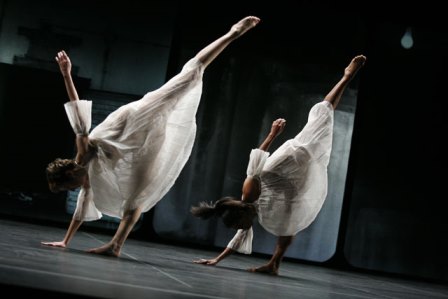2 November 2013, Palais Garnier, Paris
Triple bill programs can be mixed experiences. The Paris Opera Ballet’s recent program, with works by Saburo Teshigawara, Trisha Brown and Jiří Kylián, was a case in point: three choreographers from three very different backgrounds dealing in very different ways with the seen and the unseen, the known and the unknown, the spaces in which dance takes place.
The newly created work, Darkness is hiding black horses, by Japanese choreographer Teshigawara opened the program. Made for just three dancers, a female and two males, it was the most difficult to make sense of as it appeared to have no choreographic structure beyond a quite simple floor pattern of straight lines of movement. The dancers very rarely interacted with each other and the movement itself also seemed to have no obvious structure with the dancers moving in a kind of slinky, bendy fashion as if collapsing into and around themselves. An interview with Teshigawara in the printed program noted that the choreographer was interested in surrealism and the act of automatic writing as favoured by some artists of Dadaist bent. Darkness looked a little like a form of automatic choreography.
To tell the truth I have no idea what the work was meant to be about although publicity kept using words like black, obscurity and the like. It was performed in a kind of black box space and little puffs of smoke kept escaping into the air from jets on the floor of the stage. It was mystifying and I think presumptuous. And as for the black horses…?
Trisha Brown’s Glacial Decoy, a work she made in 1979, was welcome relief. Its exploration of the space beyond centre stage, including wing space, was lively and playful and her beautifully exuberant use of dancers picking up phrases from one another was a delight. Robert Rauschenberg’s background projections of his own black and white photographs, mostly of assorted suburban and industrial subjects, seemed to echo the choreography as they slipped across the stage from left to right in groups of four with the far right image constantly disappearing and being replaced by another on the far left.
The dancers of the Paris Opera Ballet handled Brown’s loose limbed, swinging movement and idiosyncratic gestures with style although with perhaps a little too much classicism, a feature of the performance that was more noticeable than it might have been given that Brown’s New York company was performing its own program concurrently at the Théâtre de la Ville.
But it was Jiří Kylián’s exquisite Doux mensonges that was the highlight of the evening. It is a beautifully coherent combination of dance (for four dancers only), film (shot under the stage of the Palais Garnier), song (from the group Les Arts florissants), lighting (Michael Simon) and a fabulous, hanging pinky-orange cloud-like structure that turns, folds and unfolds slowly to display varying facets of its composition (also by Michael Simon).
Doux mensonges was created in 1999 for the Paris Opera Ballet and its title might be translated as Sweet lies, although I prefer Sweet deceits. Kylián has explained that his inspiration for the piece is the duality of our personal world, the world that we show to others and allow them to share and the world that we prefer to keep hidden from others. This is best seen in the work when, after performing onstage, the dancers sometimes disappear from the stage via a trapdoor only to be seen below the stage on film (projected back up onto the stage) where a less pleasant and sometimes quite violent side, perhaps a more honest side, of their relationship is shown.
Choreographically Doux mensonges consists largely of duets, on this occasion between Eleonora Abbagnato with Vincent Chaillet and Alice Renavand with Stéphane Bullion. With its focus sometimes on extended legs and arms stretched fully to the side in lifts, it reminded me a little of the duets from Stepping Stones. But I loved the opening duet executed on the edges of a trapdoor and a later moment when in one lift the woman held her legs straight down in a 5th position and executed a series of quivering beats as she was carried across the stage.
There were so many moments of sheer inventiveness, visually, kinaesthetically and musically. Doux mensonges for me is a work of breathtaking, expressionistic beauty. It is hard to think of anything that equals it.
Michelle Potter, 6 November 2013

Unfortunately I have been unable to convince the Paris Opera Ballet of my bona fides as a writer. The press office has ignored my requests for access to images, which is a shame because Teshigawara’s costumes in particular need to be seen rather than described. C’est la vie I guess. The image above of Glacial decoy is of the Trisha Brown Dance Company and comes from their media site.
2 thoughts on “Darkness is hiding black horses, Glacial decoy, Doux mensonges. Paris Opera Ballet”